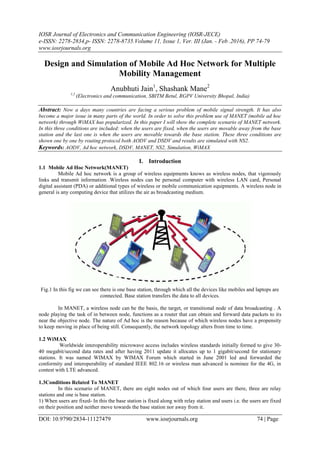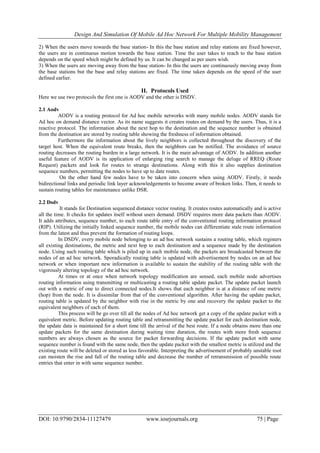1) The document simulates and compares the performance of AODV and DSDV routing protocols in a mobile ad hoc network under three conditions: when users are fixed, when users move towards the base station, and when users move away from the base station.
2) The results show that both protocols have higher packet delivery and lower packet loss when users are either fixed or moving towards the base station, since signal strength is better in those scenarios. Performance degrades when users move away from the base station due to weaker signals.
3) AODV generally has better performance than DSDV, with higher throughput and packet delivery rates observed across the different user mobility conditions.




![Design And Simulation Of Mobile Ad Hoc Network For Multiple Mobility Management
DOI: 10.9790/2834-11127479 www.iosrjournals.org 78 | Page
Fig. 6 this graph shows that what happens when the users moving towards the base station in DSDV
Table. 2 shows the results for AODV protocol when users are moving towards the base station.
Average Throughput 797.6480 kbps
Total packet sent 1720
Total packet received 1474
Packet delivery ratio 85.697674 %
Packet loss ratio 14.302326 %
Table. 3 shows the results for AODV protocol when users are moving away from the base station.
Table.4 shows the results for DSDV protocol when users are moving towards the base station
Average Throughput 657.1686 kbps
Total packet sent 1720
Total packet received 1223
Packet delivery ratio 71.104651 %
Packet loss ratio 28.895349 %
V. Conclusion
From the above all result we can conclude that if the mobile user are fix or moving towards the base
station then the signal strength will increase and high signal to noise ratio obtain due to which we got maximum
packet delivery and less packet loss for AODV as well as DSDV protocol. But if the mobile user moves away
from the base station then the strength of the signal decreases and the result for both the protocols are degrade
than other two scenarios.
VI. Future Work
In the upcoming days we will be able to implement more nodes in MANET. The number of base stat
ion, relay station and users would be increased. Recently in this paper I have used AODV and DSDV routing
protocols but in future we would be implement by many other protocols.
Refrences
[1] Mrs.S.Madhurikkha &Dr.R.Sabitha ,Defending against packet dropping attack using DRI & cross checking mechanism in MANET.
[2] Zahian Ismail& Rosilah Hassan, Effect of packet size on AODV routing protocol implementation in homogenous and heterogenous
manet-2011
[3] S.Mangai & A.Tamilarasi ,Hybrid location aided routing protocol for gps enabled manet clusters-29 Dec 2011
[4] Zhenyu Chen, Lin Guan ,Xingang Wang, Xunli Fan “Ad hoc On-demand Multipath Distance Vector routing with Backup Route
Update Mechanism” IEEE 14TH
International Conference On High Performance Computing And Communications 2012.
[5] Prabhakar D. Dorge, Sanjay S. Dorle, Megha B. Chakole and Dhiraj K. Thote , “Improvement of QoS in VANET with Different
Mobility Patterns” Proceedings of the International Conference on Radar, Communication and Computing (ICRCC 2012), SKP
Engineering College, Tiruvannamalai, TN., India. 21 - 22 December, 2012.
Average Throughput 1678.0190 kbps
Total packet sent 2375
Total packet received 1977
Packet delivery ratio 83.242105 %
Packet loss ratio 16.757895 %](https://image.slidesharecdn.com/j011137479-160806064723/85/J011137479-5-320.jpg)
![Design And Simulation Of Mobile Ad Hoc Network For Multiple Mobility Management
DOI: 10.9790/2834-11127479 www.iosrjournals.org 79 | Page
[6] Rajan patel& nimisha patel , A comparative study and simulation of AODV & DSDV manet routing protocol in ns2 & ns3- march
2014.](https://image.slidesharecdn.com/j011137479-160806064723/85/J011137479-6-320.jpg)